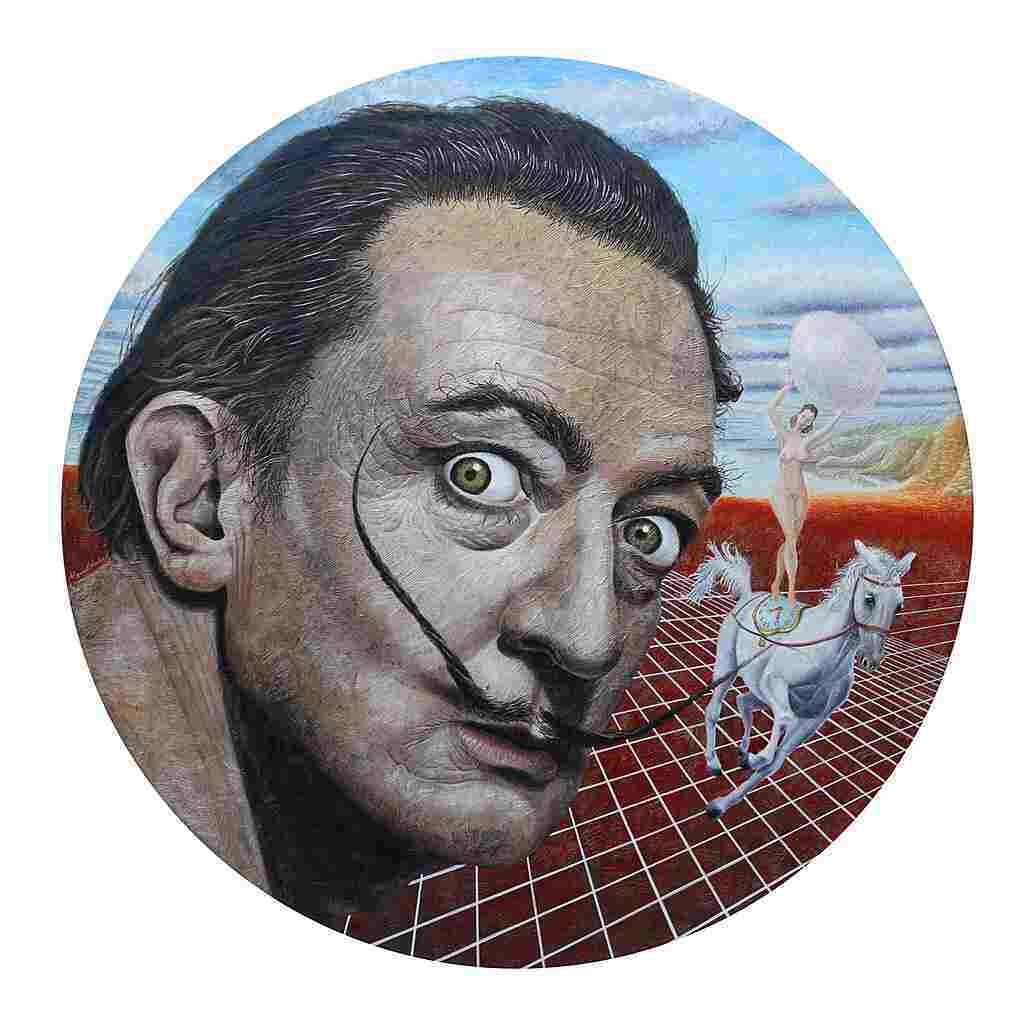Salvador Dali
The biography of Salvador Dalí
Spanish painter, Salvador Dali is one of the best-known artists of the 20th century. A master of surrealism, his works are world famous, such as the painting “The Persistence of Memory”.
Salvador Dalí was born on May 11, 1904, in Figueres, in the Empordà region. This region of Spain will inspire Dalí, present as a watermark throughout his work. It was during a visit to the port of Cadaqués that he discovered painting. He began to take engraving lessons, and it was at this time that he made his first paintings. His mother, Felipa, died when Salvador was only 16 years old. Obtaining his baccalaureate the following year, in 1922, he left to study in Madrid and entered the Royal Academy of Fine Arts of San Fernando. There he met Federico Garcia Lorca, and took a close interest in Dadaism. In 1925, Dalí exhibited at the Dalmau Gallery in Barcelona, where he notably presented the paintings Young Girl at the Window, for which his sister Ana Maria posed, and Portrait of my father. These two realistic works already show the extent of Dalí’s mastery of pictorial techniques.
Salvador Dalí discovers surrealist painting in Paris
Excluded from the Academy of Fine Arts in Madrid, Salvador Dalí went to visit Paris in 1927. There he met Pablo Picasso, whom he admired and considered a model, coupled with a rival. Living between Figueres and Paris, Dalí continues to gain artistic maturity. In 1929, thanks to his Catalan friend Joan Miró, he met and joined the circle of artists of the surrealist movement. There he met André Breton, René Magritte, Paul Éluard and other great names in painting. The short film he co-directed with Luis Buñuel, Un chien andalou, was released in theaters in Paris. The film contributes to his growing notoriety. During the summer Dalí spent with his new friends, he fell madly in love with Paul Éluard’s wife, Gala. The feelings are mutual, and the lovebirds will now spend their lives together. In 1930, Dalí and Gala acquired a small fisherman’s house close to Cadaqués, in the cove of Portlligat. During this period, Salvador Dalí found his personal style, largely influenced by surrealist painting.

A sundial painted by Salvador Dali, 27 Rue Saint-Jacques, Paris – France. Ken Eckert, CC BY-SA 4.0, via Wikimedia Commons
Persistence of memory, major painting in the work of Salvador Dalí
In 1931, Salvador Dalí painted one of his most famous canvases, Persistence of Memory. Also called Soft Watches, this painting is representative of the style so characteristic of the Spanish painter. Surrealist painting, he gives it a completely original graphic form, fruit of his overflowing imagination and influenced by psychoanalysis. Dalí, always present in the circle of surrealists, continues to exhibit regularly. He produced The Face of Mae West that could be used as a surrealist apartment in 1934. After a stint in the United States, an essential step to establish his global popularity, he stayed in Spain and Fascist Italy, during which time he painted the paintings Soft Construction with boiled beans – Premonition of the war (1936) then Spain, in 1938. Parallel to his work, Dalí organizes around himself a real cult of personality. Extravagant, deliberately provocative, he creates for himself the character of a genius and disturbed painter. He was expelled from the surrealist movement in 1939, for his declarations in favor of Hitler or Franco.
“The Persistence of Memory” by Salvador Dalí (1931), at @MuseumModernArt pic.twitter.com/2Ewa6adrlg
— vanitas (@Art_Vanitas) February 2, 2022
The many works of Salvador Dalí
In 1940, after the Spanish Civil War, Salvador Dalí painted the Face of War. Shortly after, in the middle of World War II, Dalí and Gala left Europe for the United States, where they lived for 8 years. In New York, he painted his Soft Self-Portrait with Grilled Bacon. Dalí’s favorite themes in his surrealist work are death, onanism and eroticism, putrefaction… staged with perfect technical mastery and a taste for trompe l’oeil images. He continues to be one of the leading figures of surrealism, and at the same time tries his hand at more realistic painting, especially in religious paintings (Crucifixion, 1954). A complete artist, he also distinguished himself in sculpture, advertising, the creation of jewellery, perfumes, costumes and sets… Even his own house, in Portlligat, which he transformed over the years into a veritable palace, is a surrealist work in its own right.
Read also: The Most Famous Paintings in the World
On 27/09 we will open our exhibition “Objects of Desire”, unveiling the extent to which Surrealism has influenced design of the past 100 years. An example: Salvador Dalí’s “Mae West Lips Sofa” that inspired Studio65 to create their lip-shaped sofa “Bocca”: https://t.co/JIXbSFGpkn pic.twitter.com/j1KIToQvLu
— Vitra Design Museum (@VDM_News) September 15, 2019
SALVADOR DALI: KEY DATES
May 11, 1904: Birth of Salvador Dalí
Salvador Dali was born on May 11, 1904 in Figueres, Spain. As well known for his work as for his eccentricities, Salvador Dali touched on many fields such as painting, sculpture, jewelry, architecture, literature or cinema and theater. Among the most famous elements of his style, we can cite the paranoia-critical method or the three-dimensionality.
October 1926: Dalí is expelled from the Academy of Fine Arts in Madrid
Salvador Dalí, who demonstrated the extent of his qualities as a painter by exhibiting some of his paintings in Barcelona, showed great confidence in his abilities. A confidence tinged with arrogance, since he asserted that no one at the San Fernando Academy of Fine Arts was able to examine his paintings. This insolent remark leads to his exclusion from the academy, shortly before his final exams.
November 20, 1929: First exhibition of works by Dalí
The surrealist André Breton presents in Paris the first exhibition devoted to the Spanish painter Salvador Dalí. Dalí is however not unknown to the Parisian public. In October 1928, together with director Luis Buñuel, he made the first surrealist film: Un Chien Andalou. He meets Gala, the woman of his life, the same year.
1940: Dalí and his wife leave Europe
The surrealist painter and his wife left Europe for the United States during World War II. Settled in New York, Dalí became known worldwide. He painted there, but also devoted himself to other activities: sculpture, design, advertising, jewellery, perfumery… Dalí, a complete artist, enjoyed trying out various artistic activities. The couple returned to Spain in July 1948.
September 28, 1974: Dalí inaugurates his Theatre-Museum
Salvador Dalí, thinking about the project since the 1960s, launched the construction of his Theatre-Museum in 1970. Four years later, the building he imagined as being an ultimate surrealist work came out of the ground, and was inaugurated on September 28, 1974.
June 10, 1982: Death of Gala, Dalí’s wife
Met in 1929, Gala has shared the life of Salvador Dalí since then. Having become his muse, their meeting influenced the work of the Spanish painter. They married civilly in 1932, then religiously in 1958. Dalí offered Gala the castle of Púbol, in which she lived until her death in 1982. Dalí then lived there until 1984, when a fire ravaged the castle. and forces him to return to reside in his Theatre-Museum.
January 23, 1989: Death of Salvador Dalí
The world famous Spanish painter, flamboyant and eccentric character, died at the age of 84, on January 23, 1989 in his hometown of Figueras. Suffering from Alzheimer’s since 1980, the painter is buried in the crypt of the Dalí Theatre-Museum.
2017: The series La Casa de Papel pays tribute to Dalí
A Spanish series that has met with resounding success on the Netflix streaming platform, La Casa de Papel pays tribute to Salvador Dalí. The main characters of the series, robbers carrying out the heist of the century in the National Factory of Currency and Stamps in Madrid, wear red jumpsuits and masks bearing the effigy of the painter with the croc mustache.
Sources: PinterPandai, The Art Story Fondation, Alejandra de Argos
Photo credit: Miguel Rodez, FAL, via Wikimedia Commons



